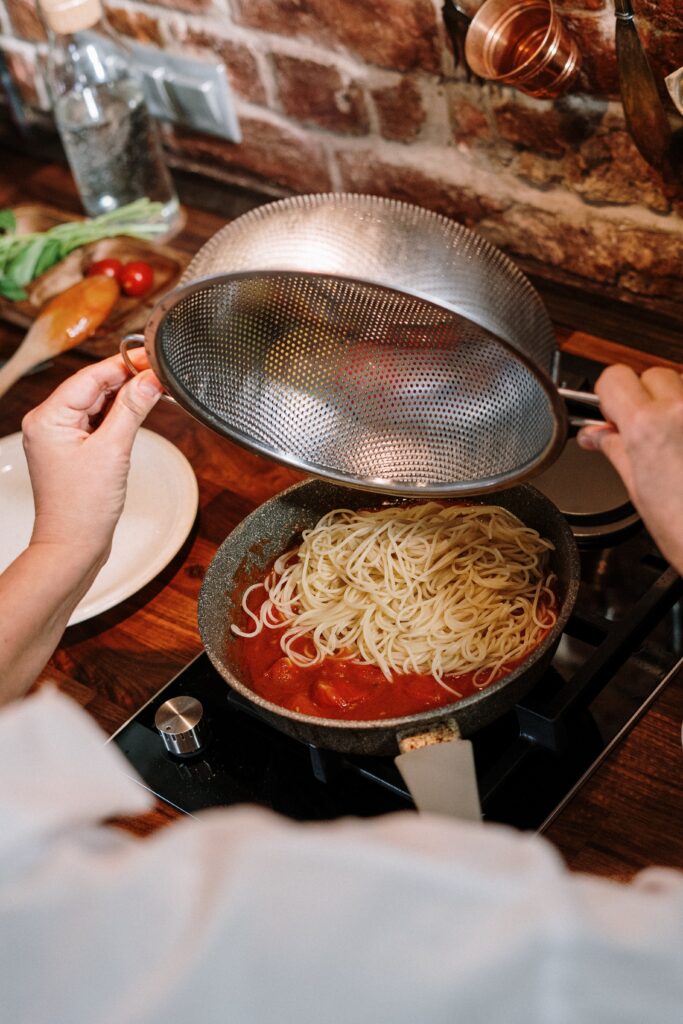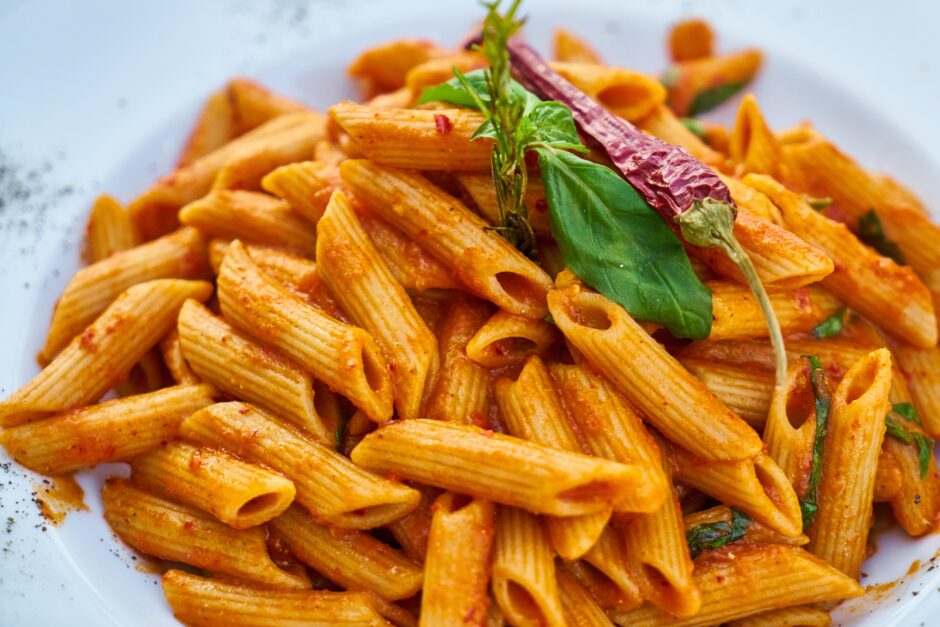I am here sitting in my living room, thinking about some of the questions I have been asked recently, and one that comes to me really often is how to sauce pasta the Italian way. It is something that most Italian can do quite well since it’s part of our culture, but of course, pasta is not a worldwide thing.
Scrolling my pasta recipes page, you can go through many different pasta preparations. In this post I try to summarize all the knowledge infused in them and create a quick “how to” for my friend all over the world! 🙂
So… how do Italians sauce pasta? Saucing pasta the Italian way may seem a hard task, but it is not if you follow this step-by-step guide, including which steps are mandatory and the things to be absolutely avoided.
In brief:
1. get your sauce done before the pasta is ready,
2. remove the pasta from the water “al dente”
3. drop it into a pan with the sauce,
4. mix it using some pasta water and some EVO oil
5. finally serve with cheese and/or herbs (if needed).
Of course, don’t overcook it, don’t let it wait for the sauce, don’t throw away all your water pasta, don’t abuse basil and parsley on top (that is an Italian American thing, not authentic). That’s all!
But let’s deep dive into the correct way to manage this task, so important to get the perfect “pasta experience“!
Step 1 – Get the sauce ready
The first thing you have to do right is: get the sauce ready before the pasta is! This is important, because pasta does not like to wait! With few exceptions, like cacio e pepe or carbonara, which are express preparations, the sauce can be prepared in advance. I actually recommend stocking up on some sauces in the freezer, for last-minute Italian dinners: bolognese ragù and pesto Genovese are the perfect examples.
Step 2 – Cook the pasta “al dente”
Many may ask: what do you mean with “al dente” (literally: “to the tooth”)? There is an easy answer and a more advanced one.
The easy answer is: just read the instructions on the pasta packaging, they always highlight the minutes required to cook it properly. My advice is: just remove the pasta from water 2 minutes earlier than as per packaging instructions.
The harder answer is: when you will be skilled enough, you will just taste the pasta and you will understand when it’s not undercooked but actually al dente and needs to be removed from the water. My advice: use the previous method and train yourself to taste the pasta when you remove it so that in a few times you will be able to just taste it … as Italians do 🙂
Why it’s important to cook pasta al dente? Because this will allow you to execute the next steps properly and get a perfect pasta!
Step 3 – In the pan!

The easiest way to move the pasta from the pot to the pan is a colander. I use it to drain the pasta water, but only after having saved a mug of it. Pasta water is rich in starch and this is an incredible asset for all your pasta recipes.
When the pasta is in the colander, drop it into the pan where you have prepared the sauce. It is very important that you don’t rinse the pasta with tap water! This is something that I have read in forums but it is definitely a mistake since it will wash away the starch from the pasta’s surface, while the starch is your best ally to make the sauce cling to the pasta.
Step 4 – Add pasta water and EVO oil (not milk cream!)
When the pasta is in the pan, mix it with the sauce. Now you need a few minutes until the pasta is completely cooked and the sauce correctly sticks to it. Consider that if you have stopped boiling the pasta two minutes earlier than expected, it will take about 4-5 minutes in the pan. During this time, you slowly add the amount of pasta water that is required to make it gently cook. The heat should be medium-high.
Another trick is to add some fat, usually EVO oil, so that starch combines (emulsifies) with it, and the sauce will perfectly cling to the pasta. This tip is super important when the sauce is a very low-fat one, e.g. a simple tomato and basil. It is also very important when the sauce is veggie-based or with large chops of fish or prawns, since it is the proper way to create an emulsion that will make the pasta cling. Another typical mistake of not-authentic Italian food is the use of milk cream (aka heavy cream). Apart from a few recipes in which milk cream is a key component (e.g. penne alla vodka, or tortellini alla panna), it is usually an easy and quick trick to create a thick sauce, but the taste of the ingredients will be flattened by the cream. So if you are wondering … do Italians use heavy cream in pasta sauces? The answer is “typically, not!”.
Step 5 – Cheese and herbs (only when needed…)
Now remove the pan from the heat and add some grated cheese, when the sauce requires it. It is not easy, but there are some general rules I want to share with you:
- never use cheese with fish or shellfish sauces – vongole, cozze, shrimps… never want cheese, no matter which one 🙂
- tomato sauce – here there is not 100% agreement, but I strongly recommend not to use cheese with simple tomato sauces
- bolognese sauce, tortellini – yes, definitely! And, of course, Parmigiano- Reggiano here
- carbonara, amatriciana, gricia, cacio e pepe – yes, pecorino here!
- always remember that Italian food is strongly regional. If you don’t know which cheese to add, use Parmigiano-Reggiano for recipes from Northern Italy, pecorino for Central Italy (e.g. Rome, Tuscany), ricotta salata (an aged variant, perfect to be grated, of fresh ricotta cheese) for Southern Italy.
Finally, serve your pasta and add some fresh herbs on top. Here my recommendation is: in Italy, a lot of pasta dishes will never be served with herbs on top, while abroad parsley and basil seem to be everywhere! Please consider that:
- basil is usually added to tomato sauce
- parsley is often used with fish or shellfish sauce
- you will never see lasagne, tortellini, bolognese ragù or carbonara, amatriciana and gricia with herbs on top! And when I say never… I mean never! 🙂
Conclusions
I hope this post will answer many of your questions about how to sauce pasta. Of course, some recipes are not suitable for this generic preparation (e.g. the iconic killer spaghetti…), but I have tried to share with you a lot of best practices that apply to most of the sauces, from a simple tomato and basil sauce to a bolognese ragu, to a complex fish and shellfish sauce like shrimp and tuna pasta.
If you found this “how-to” post useful and want to be sure to find it when you will cook your next pasta, just PIN IT! 🙂
And to end this properly… you cannot miss fare la scarpetta, i.e. clean the dish from the sauce, with a loaf of good Italian bread!
Disclosure
Some of the links above are affiliate links. This means that, at no additional cost to you, if you click through and make a purchase you will help this blog grow. I only promote affiliate programs that I believe in, and products I know about, with the aim to help you in your choices.
Buon appetito!


No Comments